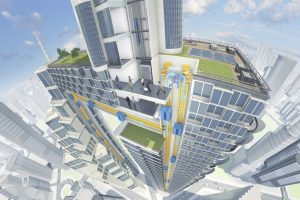Will Ropeless Elevators Change Building Design?
By TH!NK by IBI
Date
October 18, 2017Germany recently opened it’s highest viewing platform in the country, providing 360 degree views to the Black Forest from 230 metres up. But the significance of this new tower is far greater than just it’s view; the Rottweil Test Tower is a project by ThyssenKrupp to revolutionize the elevator, an invention that has not yet radically changed from it’s original design in 1854. Will this new rope-less elevator change the future of building design?
The engineers at ThyssenKrupp have named this new elevator design MULTI, a description of the multitude of possibilities inherent in this new technology. Archinect detailed the project back in 2014, describing the way the system works: “Deemed as the world’s first cable-free elevator, MULTI includes a multi-level brake system and multiple self-propelled cabins that can be incorporated within the same elevator shaft. Operating on a circular system, the elevators will be able to move vertically and horizontally in a loop at a speed of 5 m/s, powered by new linear motor technology similar to that of the Transrapid magnetic-levitation train.” This new design can move more people, in more directions, in less time, increasing the efficiency of the traditional elevator in all imaginable ways. MULTI elevators would run within the same cabin and be able to move freely between all the interconnected shafts in the building. (Watch the video embedded above for an example of this technology in action!)

Image Credit: ThyssenKrupp
What will this new elevator design mean for the future of buildings? First of all, it could significantly decrease the size of the elevator core. ThyssenKrupp estimates that usable floor area could increase by 25% with the inclusion of this new design over a conventional elevator in a high-rise. This is significant, especially with the increasing number of people living and working in cities, and the increasing construction of exceptionally tall buildings. The rope-less elevator is also significantly more energy efficient than a traditional elevator, reducing carbon emissions.
The first client has already signed on board and it is slated to be installed in OVG Real Estate’s new East Side Tower in Berlin. How will this new technology work in real projects; will it be successful? Beyond more efficient high-rises, what other projects could see significant changes from this new innovation? How would it change circulation systems in metro stations and transit hubs? How could it improve the efficiency of patient travel in hospitals? The revolutionary possibilities of this new technology look bright.
Photo by Scott Szarapka on Unsplash







